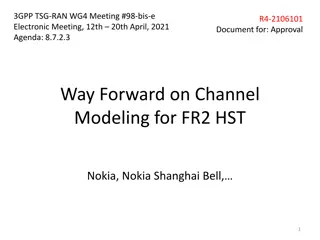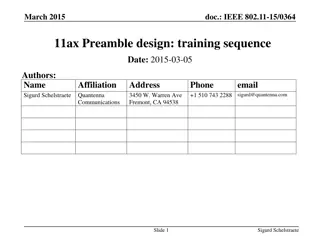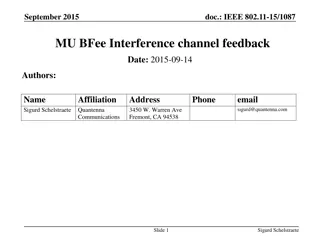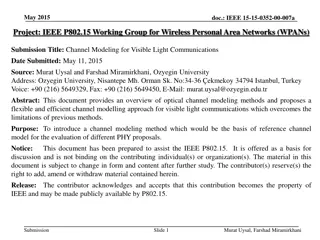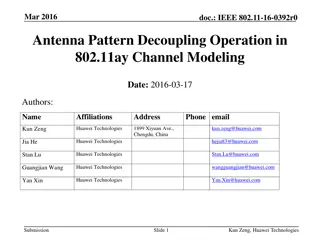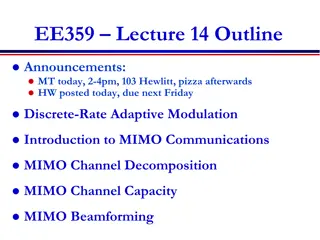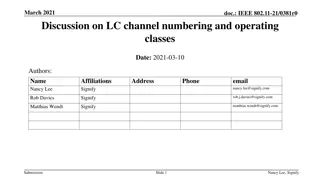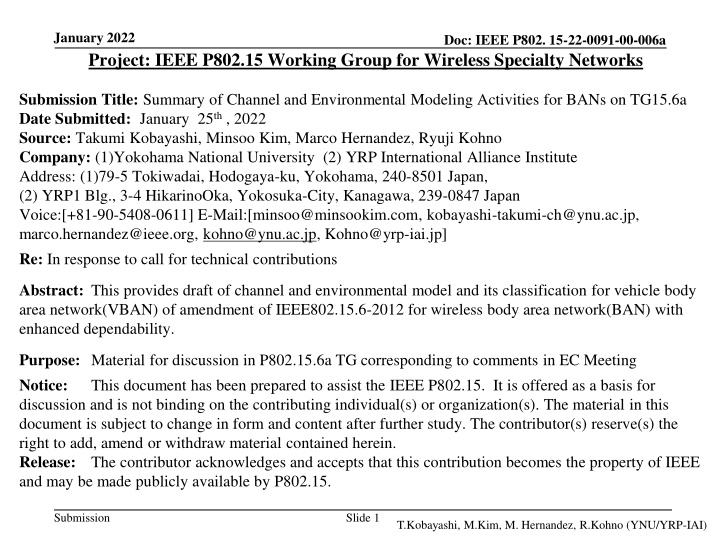
Channel and Environmental Modeling Activities for Wireless Specialty Networks
"Explore summary of channel and environmental modeling activities for wireless body area networks (BAN) on TG15.6a. Learn about the classification and models for vehicle body area networks (VBAN) with enhanced dependability. Submission includes documents on channel models and scenarios in IEEE802.15.6-2012. Key topics covered are fading, path loss, power delay profile, and more. This material serves as a basis for discussion in the IEEE P802.15.6a TG. Find insights on human and vehicle body area networks along with dynamic channel and environmental modeling schemes."
Download Presentation

Please find below an Image/Link to download the presentation.
The content on the website is provided AS IS for your information and personal use only. It may not be sold, licensed, or shared on other websites without obtaining consent from the author. If you encounter any issues during the download, it is possible that the publisher has removed the file from their server.
You are allowed to download the files provided on this website for personal or commercial use, subject to the condition that they are used lawfully. All files are the property of their respective owners.
The content on the website is provided AS IS for your information and personal use only. It may not be sold, licensed, or shared on other websites without obtaining consent from the author.
E N D
Presentation Transcript
January 2022 Doc: IEEE P802. 15-22-0091-00-006a Project: IEEE P802.15 Working Group for Wireless Specialty Networks Submission Title: Summary of Channel and Environmental Modeling Activities for BANs on TG15.6a Date Submitted: January 25th, 2022 Source: Takumi Kobayashi, Minsoo Kim, Marco Hernandez, Ryuji Kohno Company: (1)Yokohama National University (2) YRP International Alliance Institute Address: (1)79-5 Tokiwadai, Hodogaya-ku, Yokohama, 240-8501 Japan, (2) YRP1 Blg., 3-4 HikarinoOka, Yokosuka-City, Kanagawa, 239-0847 Japan Voice:[+81-90-5408-0611] E-Mail:[minsoo@minsookim.com, kobayashi-takumi-ch@ynu.ac.jp, marco.hernandez@ieee.org, kohno@ynu.ac.jp, Kohno@yrp-iai.jp] Re: In response to call for technical contributions Abstract: This provides draft of channel and environmental model and its classification for vehicle body area network(VBAN) of amendment of IEEE802.15.6-2012 for wireless body area network(BAN) with enhanced dependability. Purpose: Material for discussion in P802.15.6a TG corresponding to comments in EC Meeting Notice: This document has been prepared to assist the IEEE P802.15. It is offered as a basis for discussion and is not binding on the contributing individual(s) or organization(s). The material in this document is subject to change in form and content after further study. The contributor(s) reserve(s) the right to add, amend or withdraw material contained herein. Release: The contributor acknowledges and accepts that this contribution becomes the property of IEEE and may be made publicly available by P802.15. Submission Slide 1 T.Kobayashi, M.Kim, M. Hernandez, R.Kohno (YNU/YRP-IAI)
January 2022 Doc: IEEE P802. 15-22-0091-00-006a Summary of Channel and Environmental Modeling Activities for BANs on TG15.6a Takumi Kobayashi(1,2), Marco Hernandez(2), Minsoo Kim(2), Ryuji Kohno(1,2) (1)Yokohama National University, (2)YRP-International Ariane Institute Submission Slide 2 T.Kobayashi, M.Kim, M. Hernandez, R.Kohno (YNU/YRP-IAI)
January 2022 Doc: IEEE P802. 15-22-0091-00-006a This presentation is a summary of 3 documents below. Channel and Environmental Models of Human and Vehicle Body Area Network, doc.# 15-21-0244-06-006a Channel and Environmental Models Classification for Vehicle Body Area Network on TG15.6a, Doc.# 15-21-0560-01-006a Dynamic Channel and Environmental Modeling Scheme for BANs on TG15.6a, Doc.# 15-22-0023-00-006a Submission Slide 3 T.Kobayashi, M.Kim, M. Hernandez, R.Kohno (YNU/YRP-IAI)
January 2022 Channel models and scenarios in IEEE802.15.6-2012 Doc: IEEE P802. 15-22-0091-00-006a IEEE P802.15-08-0780-12-0006-TG6 IEEE 802.15.6-2012 channel models considered Fading ( Small scale/ large scale) Path loss Shadowing Power delay profile In-body (implant) On-body (body surface) CM1, 2, 3, 4 Scenario 1, to Scenario 7. (S1 S7) Submission Slide 4 T.Kobayashi, M.Kim, M. Hernandez, R.Kohno (YNU/YRP-IAI)
January 2022 Classification of Channel and Environment Models for Human and Vehicle Body Area Networks (HBAN&VBAN) Channel model On-body Around body not covered yet model With environ ment Doc: IEEE P802. 15-22-0091-00-006a Covered by IEEE 802.15.6-2012 HBAN model In-body (Implant) Channel Around means; Desk, WiFi AP in the room etc. Outdoor Indoor Home Office Medical (e.g. Hospital) VBAN model In-vehicle Engine compartment Cabin Through Engine compartment and cabin Roof Side Right/Left/Front/back Bottom Static vehicle Moving vehicle Note: HBAN-model: -Environment with co-existing systems is not considered. On-vehicle Around vehicle VBAN model: Key-less entry system Localization in-body, on-body Most dominant model should be defined and separatory defined as Mandatory and Optional. 5 Submission T.Kobayashi, M.Kim, M. Hernandez, R.Kohno (YNU/YRP-IAI)
September 2021 Channel and Environmental Models Doc: IEEE P802. 15-22-0091-00-006a will be defined in this amendment Environment model Channel model Environment model Channel model 1. Path loss 2. Reflection 3. Multipath 4. Fading 5. LOS / NLOS model 6. White Gaussian noise IEEE802.15.6-2012 Other wireless systems EMI EMC Time-varying modeling Colored noise 7. Interference from co-existing wireless systems e.g. Bluetooth, IEEE 802.11, IEEE 802.15.4 etc. 8. Interference from the other BANs. 9. Interference from the other electric systems, devices and components (Electro-magnetic interference; EMI from electric motors, spark plugs in vehicles, etc. 10. Electro-magnetic compatibility; EMC. Possibility to affect to the other systems and human body. 11. VBAN HBAN interference 12. VBAN and HBAN Vehicle control and human body impacts. 13. Colored noise (Impulse noise, spike noise, ignition noise etc.) 14. Time-varying channel and interference modeling (Statistic, non-static, pseudo static model) mandatory optional mandatory mandatory Comments in May 2021. optional or ? mandatory or ? mandatory optional mandatory optional Submission Slide 6 T.Kobayashi, M.Kim, M. Hernandez, R.Kohno (YNU/YRP-IAI)
January 2022 Doc: IEEE P802. 15-22-0091-00-006a Environmental model Colored noise EV Switching noise Ignition noise etc EMI from vehicle system Standard antenna Standard antenna Channel model Propagation Model based on S-V Model + RF ANT ANT RF Distance dependent function Interference from the other Wireless systems Distance dependent function Interference from the other UWB (not BAN) Interference from the other BAN We propose to define environmental models including antenna effect. Parameter measurements will be performed by using standard antennas which will be defined separately. Submission 7 T.Kobayashi, M.Kim, M. Hernandez, R.Kohno (YNU/YRP-IAI)
September 2021 Doc: IEEE P802. 15-22-0091-00-006a Environment Model in Vehicle Engine/Motor room environment model 1. Engine/motor diagnostic sensor and controller 2. Air pressure sensor, wheel health sensor and controller 3. Transmission monitoring sensor and controller Cabin room environment model 4. Cabin environment sensor (temperature, brightness, humidity etc.) 5. Sheet sensor, health care sensors for driver 6. Sheet sensor, health care sensors for passenger Note: Various type of car/vehicles Bus, Bulldozer, Heavy construction equipment needed each different sensors. 4 2 5 1 3 6 https://media.istockphoto.com/photos/transparent-car-design-wire-model3d-illustration-my-own-car- design-picture-id594040008?k=6&m=594040008&s=612x612&w=0&h=XE8LiBjpM51aB4pH2CFt6- MT6IvALRPnlxPcac0RXhg= Submission 8 T.Kobayashi, M.Kim, M. Hernandez, R.Kohno (YNU/YRP-IAI)
September 2021 Doc: IEEE P802. 15-22-0091-00-006a Engine/Motor Room Environment Many metallic components Components existing in densely Ignition noise, motor noise Especially EV Larger path-loss than free propagation A lot of reflection of RF signal Electro-magnetic interference, EMI issues https://www.as-web.jp/car/575374/attachment/03a_sub_dsc01273 Ignition coil Spark plug Electric generator Electric motor High current battery and cable Submission 9 T.Kobayashi, M.Kim, M. Hernandez, R.Kohno (YNU/YRP-IAI)
September 2021 Environment models that can be applicable against different type of vehicles Doc: IEEE P802. 15-22-0091-00-006a Cabin Engine Engine Cabin Different Size; Structure;...etc. https://nohat.cc/f/heavy-truck-illustration-isolated-on-a-white- background/comvecteezy328938-201908251309.html Categories: Categorize several type of vehicle like for passengers , bus , small cargo , middle cargo , Large cargo and special purpose vehicles such as a construction machines and build models for various categories. Policy: IEEE 802.15.6a defines several common environment models against most dominant use cases as mandatory models. Submission 10 T.Kobayashi, M.Kim, M. Hernandez, R.Kohno (YNU/YRP-IAI)
November 2021 Symmetric scenario Doc: IEEE P802. 15-22-0091-00-006a In channel model (without EMC/EMI and Interference issues), two direction of propagation should be considered as equal: Channel reciprocity. Asymmetric scenario Coordinator Node Coordinator Node Channel models of Coordinator to node and Node to coordinator without noise source should be the same. Noise and/or interference source In case of environmental model including EMC/EMI . colored noise and interference issues, two direction between source and sink is not same meaning. Coordinator Node Environmental model of two different direction should be defined separately. Coordinator Node Environmental models of Coordinator to node and Node to coordinator should be different. Submission Slide 11 T.Kobayashi, M.Kim, M. Hernandez, R.Kohno (YNU/YRP-IAI)
November 2021 Doc: IEEE P802. 15-22-0091-00-006a Use cases 1. Failure and/or deterioration detection of vehicle components. - Nodes are in engine compartment / coordinator is in engine compartment 2. Sensing for safety driving support / Collision avoidance - Nodes are on outside surface of vehicle / coordinator is in engine compartment 3. Entertainment for passengers - Nodes are in cabin / coordinator is in cabin. 4. Key-less entry system - Node is around user outside of vehicle / coordinator is in engine compartment 5. Communication between user on pedestrian and vehicle - Node is around user outside of vehicle / coordinator is on outside surface of vehicle (vehicle moves at walking speed (<5km/h)) 6. Vehicle controlling / Wireless herness - Coordinator and nodes are in between cabin and chassis of vehicle. 7. Driver s health problem detection - Coordinator in engine compartment / nodes are on human (driver) body. 8. Driver s and passenger s healthcare application - Nodes and coordinator are on human body. Submission Slide 12 T.Kobayashi, M.Kim, M. Hernandez, R.Kohno (YNU/YRP-IAI)
November 2021 Doc: IEEE P802. 15-22-0091-00-006a Use cases Use case Sedan/RV / SUV with combustion internal engine Sedan/RV / SUV EV Cargo / pickup Special purpose Bus Failure and/or deterioration detection of vehicle components 1 Case 1.1 Case 1.2 Case 1.3 Case 1.5 Case 2.1 C-N Case 2.2 C-N Case 2.3 C-N Case 2.5 C-N Sensing for safety driving support / Collision avoidance 2 Case 2.1 N-C Case 2.2 N-C Case 2.3 N-C Case 2.5 N-C Same as 3.1 3 Entertainment for passengers Case 3.1 Case 3.3 --- Case 4.1 C-N Case 4.2 C-N Case 4.3 C-N --- 4 Key-less entry system Case 4.1 N-C Case 4.2 N-C Case 4.3 N-C --- Case 5.1 C-N Case 5.3 C-N --- Communication between user on pedestrian and vehicle 5 Case 5.1 N-C Case 5.3 N-C --- Case 6.1 C-N Case 6.3 C-N Case 6.5 C-N Vehicle controlling / Wireless herness 6 Case 6.1 N-C Case 6.3 N-C Case 6.5 N-C Case 7.1 C-N Case 7.3 C-N Case 7.5 C-N Driver s health problem detection 7 Case 7.1 N-C Case 7.3 N-C Case 7.5 N-C Slide 13 T.Kobayashi, M.Kim, M. Hernandez, R.Kohno (YNU/YRP-IAI) IEEE 802.15.6 2012 Channel models can be applied Driver s and passenger s healthcare application 8 Submission
November 2021 Models between VBAN and HBAN Doc: IEEE P802. 15-22-0091-00-006a Channel and Environmental models between VBAN coordinator and VBAN coordinators. VBAN node VBAN coordinator VBAN coordinator Channel and Environmental models for VBAN. Channel and Environmental models between VBAN coordinator and HBAN coordinators. VBAN node HBAN coordi nator HBAN coordi nator HBAN coordinator HBAN coordinator Channel and Environmental models for HBAN. HBAN node HBAN node HBAN node HBAN node HBAN node Submission Slide 14 T.Kobayashi, M.Kim, M. Hernandez, R.Kohno (YNU/YRP-IAI)
January 2022 Channel and Environmental models between VBAN and HBAN Doc: IEEE P802. 15-22-0091-00-006a On-vehicle to On vehicle(LOS) On-vehicle to On Body On-body to On-body In-Vehicle to On-body Submission Slide 15 T.Kobayashi, M.Kim, M. Hernandez, R.Kohno (YNU/YRP-IAI)
January 2022 Scenario 3 Doc: IEEE P802. 15-22-0091-00-006a Geometrical configuration Nodes and coordinator are in cabin room Coordinator and node Noise source Use case 3 Entertainment for passengers - Nodes are in cabin room / coordinator is in cabin room. - Symmetric environmental model - EMI from engine and electric system are negligible. => channel model Sedan/RV / SUV with engine Sedan/RV / SUV without engine Cargo / pickup Special purpose Use case Bus Same as 3.1 3 Entertainment for passengers Case 3.1 Case 3.3 --- Submission 16 T.Kobayashi, M.Kim, M. Hernandez, R.Kohno (YNU/YRP-IAI)
January 2022 Scenario 3 for BUS Doc: IEEE P802. 15-22-0091-00-006a Geometrical configuration Nodes and coordinator are in cabin room VBAN Coordinator HBAN Coordinator Noise source coordinator Use case 3 Entertainment for passengers - Nodes are in cabin room / coordinator is in cabin room. Sedan/RV / SUV with engine Sedan/RV / SUV without engine Cargo / pickup Special purpose Bus VBAN coordinator and VBAN coordinator Same as 3.1 Case 3.1a Case 3.3 --- 3 VV VBAN coordinator and HBAN coordinator Case 3.1b --- 3 VH Submission 17 T.Kobayashi, M.Kim, M. Hernandez, R.Kohno (YNU/YRP-IAI)
January 2022 Scenario 4 Engine compartment / body surface (outside) VBAN Coordinator Doc: IEEE P802. 15-22-0091-00-006a Geometrical configuration HBAN Coordinator Noise source Use case 4 Key-less entry system - Node is around user outside of vehicle / coordinator is in Engine compartment - Asymmetric environment. Two direction model should be defined separatory. Sedan/RV / SUV with engine Sedan/RV / SUV without engine Cargo / pickup Special purpose Use case Bus Case 4.1 V-H Case 4.2 V-H Case 4.3 V-H --- 4 Key-less entry system Case 4.1 H-V Case 4.2 H-V Case 4.3 H-V --- Submission 18 T.Kobayashi, M.Kim, M. Hernandez, R.Kohno (YNU/YRP-IAI)
January 2022 Scenario 5 Outside surface of vehicle / coordinator is in Engine compartment Doc: IEEE P802. 15-22-0091-00-006a Geometrical configuration VBAN Coordinator HBAN Coordinator Noise source Moving at walking speed (<5km/h) Use case 5 Communication between user on pedestrian and vehicle - Node is around user outside of vehicle / coordinator is on outside surface of vehicle (vehicle moves in walking speed (<5km/h)) - Asymmetric environmental model Sedan/RV / SUV with engine without engine Sedan/RV / SUV Cargo / pickup Special purpose Use case Bus Case 5.1 V-H Case 5.3 V-H --- Communication between user on pedestrian and vehicle 5 Case 5.1 H-V Case 5.3 H-V --- Submission 19 T.Kobayashi, M.Kim, M. Hernandez, R.Kohno (YNU/YRP-IAI)
January 2022 Dynamic Channel Models Situations Doc: IEEE P802. 15-22-0091-00-006a 1. Channel between a user on pedestrian and a vehicle. VBAN Coordinator HBAN Coordinator Noise source Moving at walking speed (<5km/h) 2. Users in a vehicle are slightly moving due to vibration and acceleration. 3. Walking and/or standing users on a bus. 4. Between a tractor and trailer tail. LOS LOS NLOS Submission Slide 20 T.Kobayashi, M.Kim, M. Hernandez, R.Kohno (YNU/YRP-IAI)
January 2022 Dynamic on-body channel modeling Doc: IEEE P802. 15-22-0091-00-006a Timo Kumpuniemi, Matti H m l inen, Kamya Yekeh Yazdandoost, Jari Iinatti, Dynamic On-Body UWB Radio Channel Modeling , ISMICT2015, (2015) Dynamic parameters were derived categorizing the links into three classes: high, medium or low dynamics channels. (T. Kumpuniemi et al. 2015) The work is based on frequency domain measurements with a vector network analyzer in an anechoic chamber at a 2-8 GHz frequency band. channel characteristics and [ref] Timo Kumpuniemi, Matti H m l inen, Kamya Yekeh Yazdandoost, Jari Iinatti, Dynamic On-Body UWB Radio Channel Modeling , ISMICT2015, (2015) Submission Slide 21 T.Kobayashi, M.Kim, M. Hernandez, R.Kohno (YNU/YRP-IAI)
January 2022 Dynamic off-body channel modeling Doc: IEEE P802. 15-22-0091-00-006a Timo Kumpuniemi, Juha-Pekka M kel , Matti H m l inen, Kamya Yekeh Yazdandoost, Jari Iinatti, Measurements and Analysis on Dynamic Off-Body Radio Channels at UWB Frequencies , ISMICT2019. (2019) Dynamic offbody radio channels in an UWB frequency range for wireless BAN was presented (T. Kumpuniemi et al. 2019) . Ten frequencies were examined at two links, and the path loss values and standard deviations were determined. Then, all the links were considered at three discrete frequencies. Timo Kumpuniemi, Juha-Pekka M kel , Matti H m l inen, Kamya Yekeh Yazdandoost, Jari Iinatti, Measurements and Analysis on Dynamic Off-Body Radio Channels at UWB Frequencies , ISMICT2019. (2019) Submission Slide 22 T.Kobayashi, M.Kim, M. Hernandez, R.Kohno (YNU/YRP-IAI)
January 2022 Summary Doc: IEEE P802. 15-22-0091-00-006a 1. Environment model which has wider meaning than channel model has been proposed. 2. Environment model including not only channel characteristics but also including interference, colored noise, EMC and human impact issues. 3. Channel and Environmental models discussed in TG6a were described. 4. Importance to discuss dynamic and time-varying channel and environment modeling against person (user) and vehicle mobility was explained. Submission Slide 23 T.Kobayashi, M.Kim, M. Hernandez, R.Kohno (YNU/YRP-IAI)
January 2022 Doc: IEEE P802. 15-22-0091-00-006a Thank you for your attention Submission Slide 24 T.Kobayashi, M.Kim, M. Hernandez, R.Kohno (YNU/YRP-IAI)




